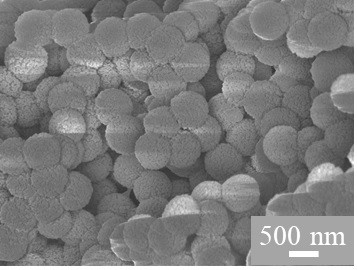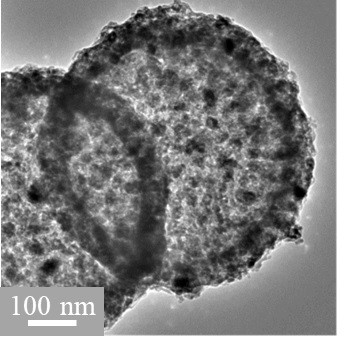A hollow structure transition metal cobalt and nitrogen co-doped carbon oxygen reduction catalyst and its preparation method and application
A transition metal and catalyst technology, applied in the field of catalyst preparation, can solve the problems of easy collapse of the structure, influence on the performance of catalytic activity, insufficient exposure of active sites, etc., and achieve the effects of low cost, excellent oxygen reduction catalytic activity and abundant reserves.
- Summary
- Abstract
- Description
- Claims
- Application Information
AI Technical Summary
Problems solved by technology
Method used
Image
Examples
Embodiment 1
[0034] Using sulfonated polystyrene microspheres with zeolite imidazolate framework compound materials (ZIF-67) grown on the surface as precursors, cobalt and nitrogen co-doped carbon-oxygen reduction catalysts are prepared by high-temperature pyrolysis carbonization, including the following steps:
[0035]Use 10% sodium hydroxide solution to wash styrene monomer and divinylbenzene monomer, and then use deionized water to wash styrene to neutrality; dissolve 0.7 g of cross-linking agent divinylbenzene in 120 mL of ultrapure water, stir evenly, add 14 g of styrene, heat under an inert atmosphere for 1 h, dissolve 0.03 g of potassium persulfate in 10 mL of deionized water, add it to the reaction system, and continue the reaction for 10 h; A saturated NaCl solution was added to the above reaction product, and the precipitate was filtered and dried to obtain polystyrene microspheres. Mix 1.70 g of the polystyrene microsphere template and 60 mL of concentrated sulfuric acid into a ...
Embodiment 2
[0039] The operating conditions were the same as in Example 1, except that during the preparation of the precursor, the reaction time was increased to 18 h. Oxygen reduction performance test of catalyst prepared by pyrolysis carbonization ( Figure 4 ) indicates that the catalyst still exhibits excellent catalytic activity for oxygen reduction.
Embodiment 3
[0041] The operating conditions were the same as in Example 1, except that during the preparation of the precursor, the reaction time was increased to 22 h. Oxygen reduction performance test of catalyst prepared by pyrolysis carbonization ( Figure 4 ) indicates that the catalyst still exhibits excellent catalytic activity for oxygen reduction.
PUM
 Login to View More
Login to View More Abstract
Description
Claims
Application Information
 Login to View More
Login to View More - R&D
- Intellectual Property
- Life Sciences
- Materials
- Tech Scout
- Unparalleled Data Quality
- Higher Quality Content
- 60% Fewer Hallucinations
Browse by: Latest US Patents, China's latest patents, Technical Efficacy Thesaurus, Application Domain, Technology Topic, Popular Technical Reports.
© 2025 PatSnap. All rights reserved.Legal|Privacy policy|Modern Slavery Act Transparency Statement|Sitemap|About US| Contact US: help@patsnap.com



